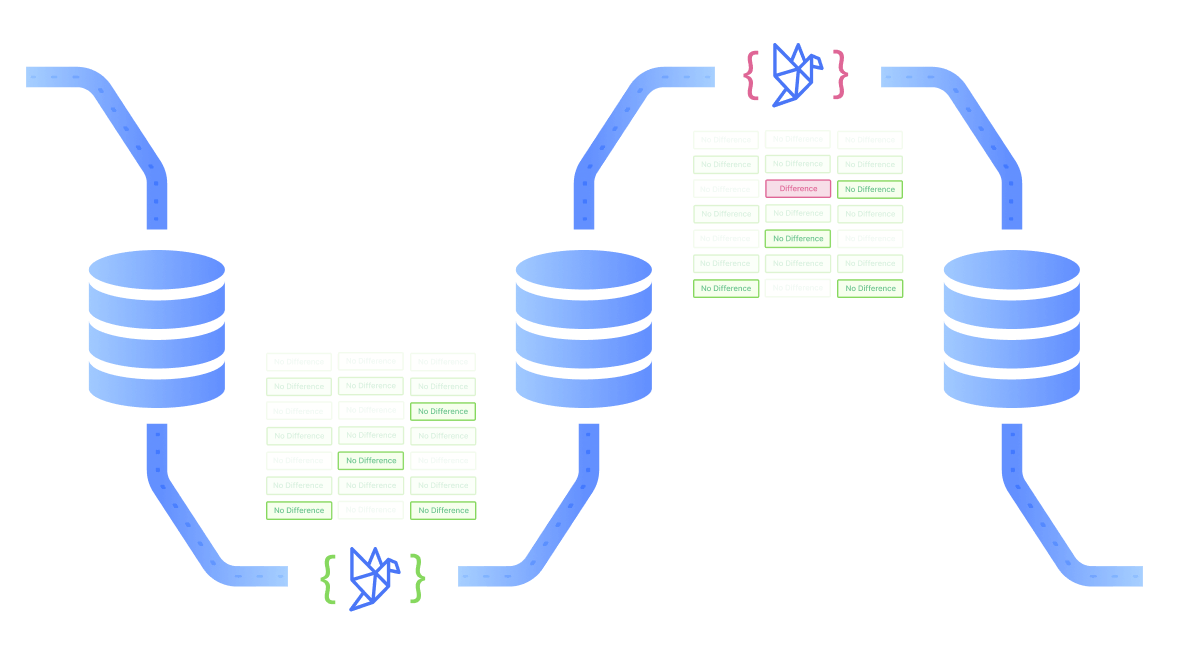A data diff is the value-level comparison between two tables—used to identify critical changes to your data and guarantee data quality.
There is a lot you can do with data-diff: you can test SQL code by comparing development or staging environment data to production, or compare source and target data to identify discrepancies when moving data between databases.
data-diff is an open source utility for running stateless diffs as a great single player experience.
Scale up with Datafold Cloud to make data diffing a company-wide experience to both supercharge your data diffing CLI experience (ex: data-diff --dbt --cloud) and run diffs manually in your CI process and within the Datafold UI. This includes column-level lineage with BI tool integrations, CI testing, faster cross-database diffing, and diff history.
When developing SQL code, data-diff helps you validate and preview changes by comparing data between development/staging environments and production. Here's how it works:
- Make a change to your SQL code
- Run the SQL code to create a new dataset
- Compare this dataset with its production version or other iterations
data-diff is a powerful tool for comparing data when you're moving it between systems. Use it to ensure data accuracy and identify discrepancies during tasks like:
- Migrating to a new data warehouse (e.g., Oracle -> Snowflake)
- Validating SQL transformations from legacy solutions (e.g., stored procedures) to new transformation frameworks (e.g., dbt)
- Continuously replicating data from an OLTP database to OLAP data warehouse (e.g., MySQL -> Redshift)
data-diff integrates with dbt Core to seamlessly compare local development to production datasets.
Learn more about how data-diff works with dbt:
- Read our docs to get started with data-diff & dbt or 👀 watch the 4-min demo video
- dbt Cloud users should check out Datafold's out-of-the-box deployment testing integration
- Get support from the dbt Community Slack in #tools-datafold
Looking to use data-diff in dbt development?
Development testing with Datafold enables you to see the impact of dbt code changes on data as you write the code, whether in your IDE or CLI.
Head over to our data-diff + dbt documentation to get started with a development testing workflow!
- Install
data-diffwith adapters
To compare data between databases, install data-diff with specific database adapters. For example, install it for PostgreSQL and Snowflake like this:
pip install data-diff 'data-diff[postgresql,snowflake]' -U
Additionally, you can install all open source supported database adapters as follows.
pip install data-diff 'data-diff[all-dbs]' -U
- Run
data-diffwith connection URIs
Then, we compare tables between PostgreSQL and Snowflake using the hashdiff algorithm:
data-diff \
postgresql://<username>:'<password>'@localhost:5432/<database> \
<table> \
"snowflake://<username>:<password>@<account>/<DATABASE>/<SCHEMA>?warehouse=<WAREHOUSE>&role=<ROLE>" \
<TABLE> \
-k <primary key column> \
-c <columns to compare> \
-w <filter condition>- Set up your configuration
You can use a toml configuration file to run your data-diff job. In this example, we compare tables between MotherDuck (hosted DuckDB) and Snowflake using the hashdiff algorithm:
## DATABASE CONNECTION ##
[database.duckdb_connection]
driver = "duckdb"
# filepath = "datafold_demo.duckdb" # local duckdb file example
# filepath = "md:" # default motherduck connection example
filepath = "md:datafold_demo?motherduck_token=${motherduck_token}" # API token recommended for motherduck connection
[database.snowflake_connection]
driver = "snowflake"
database = "DEV"
user = "sung"
password = "${SNOWFLAKE_PASSWORD}" # or "<PASSWORD_STRING>"
# the info below is only required for snowflake
account = "${ACCOUNT}" # by33919
schema = "DEVELOPMENT"
warehouse = "DEMO"
role = "DEMO_ROLE"
## RUN PARAMETERS ##
[run.default]
verbose = true
## EXAMPLE DATA DIFF JOB ##
[run.demo_xdb_diff]
# Source 1 ("left")
1.database = "duckdb_connection"
1.table = "development.raw_orders"
# Source 2 ("right")
2.database = "snowflake_connection"
2.table = "RAW_ORDERS" # note that snowflake table names are case-sensitive
verbose = false- Run your
data-diffjob
Make sure to export relevant environment variables as needed. For example, we compare data based on the earlier configuration:
# export relevant environment variables, example below
export motherduck_token=<MOTHERDUCK_TOKEN>
# run the configured data-diff job
data-diff --conf datadiff.toml \
--run demo_xdb_diff \
-k "id" \
-c status
# output example
- 1, completed
+ 1, returned- Review the output
After running your data-diff job, review the output to identify and analyze differences in your data.
Check out documentation for the full command reference.
| Database | Status | Connection string |
|---|---|---|
| PostgreSQL >=10 | 🟢 | postgresql://<user>:<password>@<host>:5432/<database> |
| MySQL | 🟢 | mysql://<user>:<password>@<hostname>:5432/<database> |
| Snowflake | 🟢 | "snowflake://<user>[:<password>]@<account>/<database>/<SCHEMA>?warehouse=<WAREHOUSE>&role=<role>[&authenticator=externalbrowser]" |
| BigQuery | 🟢 | bigquery://<project>/<dataset> |
| Redshift | 🟢 | redshift://<username>:<password>@<hostname>:5439/<database> |
| DuckDB | 🟢 | duckdb://<filepath> |
| MotherDuck | 🟢 | duckdb://<filepath> |
| Microsoft SQL Server* | 🟢 | mssql://<user>:<password>@<host>/<database>/<schema> |
| Oracle | 🟡 | oracle://<username>:<password>@<hostname>/servive_or_sid |
| Presto | 🟡 | presto://<username>:<password>@<hostname>:8080/<database> |
| Databricks | 🟡 | databricks://<http_path>:<access_token>@<server_hostname>/<catalog>/<schema> |
| Trino | 🟡 | trino://<username>:<password>@<hostname>:8080/<database> |
| Clickhouse | 🟡 | clickhouse://<username>:<password>@<hostname>:9000/<database> |
| Vertica | 🟡 | vertica://<username>:<password>@<hostname>:5433/<database> |
*MS SQL Server support is limited, with known performance issues that are addressed in Datafold Cloud.
- 🟢: Implemented and thoroughly tested.
- 🟡: Implemented, but not thoroughly tested yet.
Your database not listed here?
- Contribute a new database adapter – we accept pull requests!
- Get in touch about enterprise support and adding new adapters and features
data-diff efficiently compares data using two modes:
joindiff: Ideal for comparing data within the same database, utilizing outer joins for efficient row comparisons. It relies on the database engine for computation and has consistent performance.
hashdiff: Recommended for comparing datasets across different databases or large tables with minimal differences. It uses hashing and binary search, capable of diffing data across distinct database engines.
Click here to learn more about joindiff and hashdiff
- Recommended for comparing data within the same database
- Uses the outer join operation to diff the rows as efficiently as possible within the same database
- Fully relies on the underlying database engine for computation
- Requires both datasets to be queryable with a single SQL query
- Time complexity approximates JOIN operation and is largely independent of the number of differences in the dataset
- Recommended for comparing datasets across different databases
- Can also be helpful in diffing very large tables with few expected differences within the same database
- Employs a divide-and-conquer algorithm based on hashing and binary search
- Can diff data across distinct database engines, e.g., PostgreSQL <> Snowflake
- Time complexity approximates COUNT(*) operation when there are few differences
- Performance degrades when datasets have a large number of differences
For detailed algorithm and performance insights, explore here, or head to our docs to learn more about how Datafold diffs data.
We thank everyone who contributed so far!
We'd love to see your face here: Contributing Instructions
This project is licensed under the terms of the MIT License.


